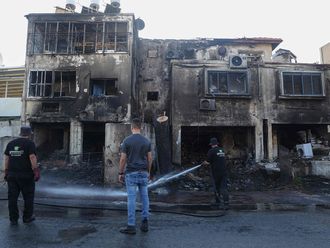
Manila: Three hundred homes were destroyed in a fire that tore through a slum in the Philippine capital on Thursday, forcing residents to make dramatic escapes, authorities said.
A bare-chested man with a cigarette in his mouth, a Jesus statue in one hand and toiletries in the other ran down a narrow, smoke-filled alley just a few minutes walk from the glistening sky-rises of Manila’s financial district.
A neighbour fled by jumping through an upstairs window and sprinting across rusted tin roofs.
Crying children were separated from their parents amid the chaos of adults carrying refrigerators, televisions, pots and pets from their homes.
“We were on the cot lying down, and then people started running. There was smoke everywhere, the place was up in flames,” said a tearful Anna Anciller, 27, on a nearby footpath while the fire was at its peak.
“We just ran. I lost everything,” she said, clutching her six-year-old daughter and breastfeeding her months-old baby boy.
Homes made of scrap wood and plastic sheets crumbled to the ground during the two-hour blaze, as portable cooking gas tanks exploded and the sirens of fire fighting trucks wailed.
The firemen walked onto the roofs of homes not yet ablaze to get their hoses close to the flames, risking a deadly fall.
No-one died but about one third of the 1,000 homes in the slum were destroyed, according to local fire chief Ricardo Perdigon.
While heart-breaking, the scenes at the “Botanical Garden” shantytown are common throughout the vast slums that dominate Manila.
Homes mostly made of salvaged wood and plastic are tinder boxes waiting to be ignited by makeshift electricity networks, cigarettes or gas cooking.
An arson investigator said Thursday’s blaze was likely caused by a faulty power outlet.
About 35 per cent of the capital’s 14 million population live in slums, according to a 2010 World Health Organisation study.
The widespread poverty and brutal conditions in the slums were among the reasons US author Dan Brown described Manila in his latest novel as the “Gates of Hell”.
Authorities have for years tried to relocate slum dwellers away from the city to safer areas, but the vast majority prefer to remain closer to work opportunities.
“There is nowhere else for us to go. There are no jobs in the provinces,” said longtime Botanical Garden resident Jenny San Gaspar, a 38-year-old housewife and mother of 10.
Local politicians also like to keep the slum dwellers in the city to be used as reliable “vote banks” during elections.
And just a few hours after the inferno was extinguished, shirtless men and elderly women were bringing back their salvaged belongings, staking out positions in the blackened ashes to rebuild new homes.











